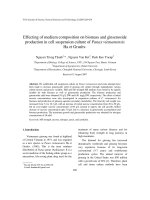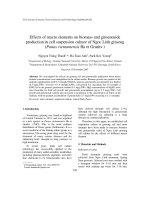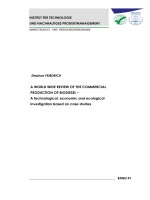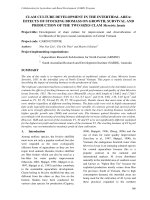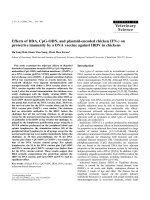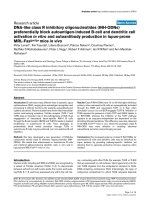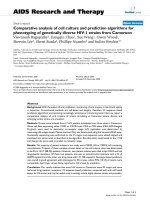Production of cell culture based vaccine and DNA Recombinant vaccine against Hydro Pericardium Syndrome (HPS) virus of poultry and their comparison through ELISA.
Bạn đang xem bản rút gọn của tài liệu. Xem và tải ngay bản đầy đủ của tài liệu tại đây (1.56 MB, 14 trang )
Research and
Development on Hydro
Pericardium Syndrome
virus vaccine
M. Salah-ud-Din Shah, DVM, M.Sc.
(Hons)
Biological Chemistry Division, NIAB
INTRODUCTION
• Hydropericardium Syndrome is a viral
disease of poultry caused by Avi Adeno
virus- 4 (Rabbani et al., 1998)
• It was first observed in 1987 at Angara
goth, a broiler growing area near
Karachi, Pakistan. So the syndrome was
named as Angara disease (Jaffery,
1988).
• This disease causes heavy losses every
year, mortality rate is 50-70%
• Vaccine available in market is 25% of
total population (170 M)
STATUS OF AVAILABLE
VACCINES
• At present vaccines available in
market are produced from crude
methods e.g. formalized liver
homogenate, these vaccines have
following short comings
• They carry proteins of livers
• Pathogens other than adeno virus if
birds are infected
• These vaccines have very short shelf
life (only 2-3 months)
• Vaccine failure is very common
PREVIOUS WORK
• Vaccine is Produced from crude method with
slight modifications
• Virus is extracted & purified by
centrifugation
• Contains no liver protein
• Monitoring of chicks for any other disease to
avoid other pathogens
• Addition of antibiotics to increase shelf life
for one year
• Addition of Vitamin E and Selenium
Marker
116 kDa
66.2 kDa
45 kDa
35 kDa
25 kDa
14.4 kDa
18.2 kDa
1
2
3
4
6
No. of Daily Mortalities in infected flock
after vaccination
Weakly Antibody titer of broilers after
vaccination in treated & control group
Brochure of HPS Vaccine
PLAN OF WORK
• Following techniques can be used for
production of standard vaccine
• Cell culture based vaccine production
• DNA recombinant vaccine production
• Trials of both vaccines and
comparison through ELISA
CELL CULTURE BASED
VACCINE
• This virus can be grown on chicken
hepatocytes cultured in vitro by following
steps (Hess et al. 1998)
• Culturing of primary chicken hepatocytes in
cell culture media (M - 199) to obtain
monolayer in cell culture flasks
• Inoculation of adeno virus on monolayer of
cells and allow the virus to grow on cells
• Extraction of virus from cells after observing
cytopathic effects, quantification by ELISA,
then use this virus as antigen in vaccine
DNA RECOMBINANT
VACCINE
• Extraction of viral DNA from samples of
•
•
•
•
infected chicks (Kao et al. 2000)
Amplification of HPS virus surface
antigen gene by PCR (Jiang et al.,1999)
Ligate HPS virus surface antigen gene in
cloning vector
Transform ligated Product in E. coli
Screen and select the recombined clone
• Confirm the clone by running the sample
on 1% agarose gel
• DNA sequencing
• Detect the cloned protein by ELISA.
• Selected cloned colony will be used for
antigen in vaccine production
EVALUATION OF VACCINES
• Trials of both vaccines will be done by
vaccinating the birds first on small scale
then on large scale in field conditions
• Collection of serum samples from
vaccinated birds
• ELISA will be performed at end for
determination of antibody titers to
evaluate both vaccines (Dawson et al.,
1998)
Thanks
